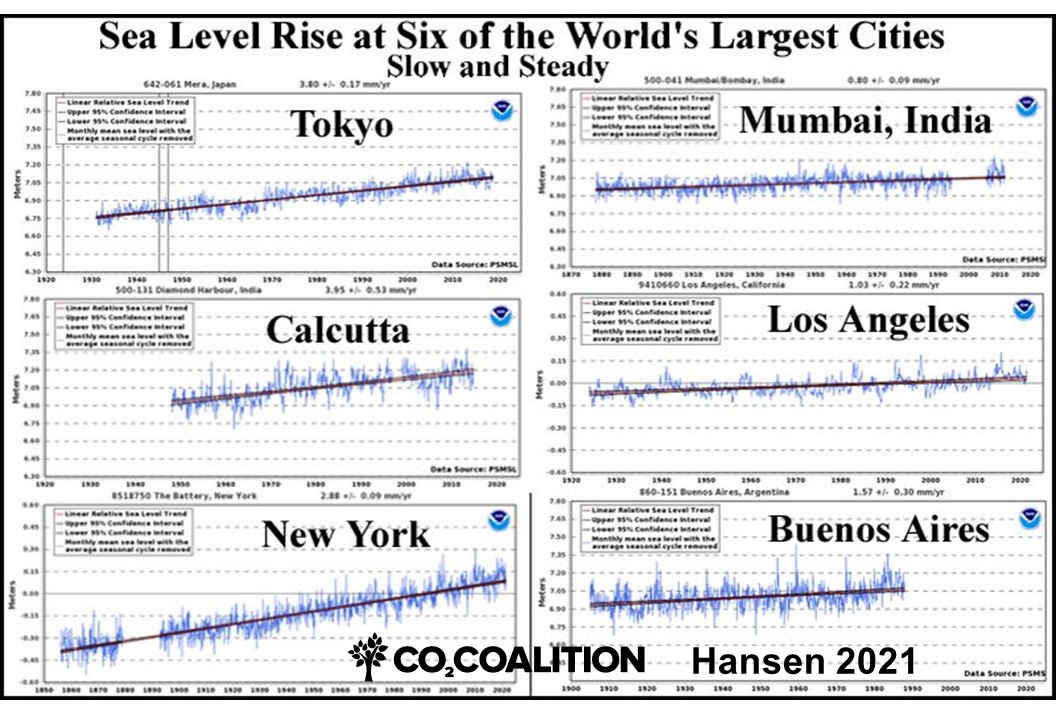Dr. Patrick Moore & Dr. Caleb Rossiter Rebut Wash Post: Oops! Climate Change Actually NOT the Cause of Coastal Flooding
Dr. Patrick Moore & Dr. Caleb Rossiter Rebut Wash Post: Oops! Climate Change Actually NOT the Cause of Coastal Flooding
By Patrick Moore and Caleb Stewart Rossiter
Consumers of the climate religion media – which comprises pretty much every outlet from CNN leftward – should be forgiven for believing that a climate crisis requires that we ban the cheap, reliable energy that powers 80 percent of the world economy. After all, those outlets only run stories on one side of the question and brook no debate. The recent “Earth Day” issue of the Washington Post Sunday magazine is a case in point. It was devoted to finding evidence of climate changes caused by the warming gases that are emitted when fossil fuels are converted to energy. The most important of these emissions, by far, is carbon dioxide, a non-toxic plant, and plankton food. Unfortunately, the evidence started out weak and got weaker. And of course, the magazine refused to run letters pointing that out.

There was the requisite image of a polar bear clinging to a melting iceberg, and a story on lower counts of wood thrush in the DC region. But neither of those has anything to do with climate change. Polar bear counts, as all researchers have shown since the elegant animal became a favored fund-raiser for Green groups 20 years ago, are increasing. The wood thrush story itself pointed out that housing development and deer density are the primary problems.
The final insult to scientific fact, though, was the centerpiece story on flooding in communities around Norfolk, Virginia, which was presented with this subtitle: “Climate change is forcing many communities to imagine leaving the waterfront behind.” That claim mirrors the U.S. government’s 2018 summary National Climate Assessment, which includes Norfolk and its U.S. naval facilities as examples of places threatened by rising seas due to CO2-driven climate change.
However, according to the UN’s most recent report, the current global rate of sea-level rise – about an inch a decade, or 3.2 millimeters per year – is the same as it was 100 years ago. These estimates are uncertain, as sea-level is difficult to measure, but it is clear that the rise is related to the steady increase in global temperature since the Little Ice Age ended around 1800. All of this, of course, was long before 1950, which the UN reports was when industrial carbon dioxide was first emitted in sufficient quantities to cause measurable warming. Ironically, this UN information about sea-level rates being the same before and after CO2 warming was included in the scientifically-detailed version of the National Climate Assessment, contradicting the widely-publicized summary.
 Sea-level rates include the fall, or “subsidence,” of land due to a variety of natural and human-caused processes that have nothing to do with temperature. The reason that sea-level rise is higher than average (about 3.9 mm per year, according to the U.S. Geological Service) at the mouth of the Chesapeake is that the land there is sinking at a rate that far exceeds the global subsidence rate. Who says so? Every scientist who studies it, as shown in the U.S. Geological Service’s 2013 report, Land Subsidence and Relative Sea-Level Rise in the Southern Chesapeake Bay Region: “Land subsidence has been observed since the 1940s in the southern Chesapeake Bay region at rates of 1.1 to 4.8 millimeters per year (mm/yr), and subsidence continues today. This land subsidence helps explain why the region has the highest rates of sea-level rise on the Atlantic Coast of the United States. Data indicate that land subsidence has been responsible for more than half the relative sea-level rise measured in the region.”
Sea-level rates include the fall, or “subsidence,” of land due to a variety of natural and human-caused processes that have nothing to do with temperature. The reason that sea-level rise is higher than average (about 3.9 mm per year, according to the U.S. Geological Service) at the mouth of the Chesapeake is that the land there is sinking at a rate that far exceeds the global subsidence rate. Who says so? Every scientist who studies it, as shown in the U.S. Geological Service’s 2013 report, Land Subsidence and Relative Sea-Level Rise in the Southern Chesapeake Bay Region: “Land subsidence has been observed since the 1940s in the southern Chesapeake Bay region at rates of 1.1 to 4.8 millimeters per year (mm/yr), and subsidence continues today. This land subsidence helps explain why the region has the highest rates of sea-level rise on the Atlantic Coast of the United States. Data indicate that land subsidence has been responsible for more than half the relative sea-level rise measured in the region.”
Why is land falling around Norfolk? As the USGS points out, “most land subsidence in the United States is caused by human activities.” The withdrawal of groundwater for human use and agriculture causes 80 percent of it nationally. In the Norfolk area, the USGS reports that water use compacts the clay layers in the aquifer system, permanently. That is why the USGS recommends moving Norfolk’s pumping activities far inland. Groundwater levels have already fallen by about 200 feet around Norfolk in the past century. But in Norfolk, there is yet another important source of land subsidence: what the USGS calls “glacial isostatic adjustment” and estimates at one mm per year. As land levels a few hundred miles north of Norfolk rebound from the melting of heavy, mile-high ice 18,000 to 12,000 years ago, Norfolk sinks in response.
For purposes of comparison, let’s use the data for the longest periods in the USGS report’s Chart 3: 3.9 mm annual rise in sea-level, but a long-term global average of 1.8 mm, both of which include land subsidence. But the local land subsidence is 2.8 mm, meaning that at least 72 percent of the change in flooding is due not to rising seas but sinking lands. Yet in the magazine article, there is no mention – not one word out of thousands – about land subsidence.
An additional possible factor in land subsidence is the geology around Norfolk, which is unique in America due to a remarkable event 35 million years ago: the impact of an asteroid that left a crater right at the opening of the Chesapeake 55 miles around and a mile deep. Some USGS scientists see the crater as a continuing factor in land subsidence, while others, as in the 2013 summary report, discount it. Like the rest of the possible factors in sea-level rise in Norfolk, the crater has nothing to do with CO2-driven “climate change.”
About the Authors
Ecologist Patrick Moore is the chair of the CO2 Coalition of 55 climate scientists and energy economists. Dr. Moore was a long-time leader of Greenpeace and leads the Allow Golden Rice Now campaign.
Climate statistician Caleb Stewart Rossiter is the Coalition’s executive director. Dr. Rossiter was formerly a professor of international affairs, mathematics, and statistics at American University.
This article appeared on the Climate Depot website at https://www.climatedepot.com/2020/05/07/dr-patrick-moore-dr-caleb-rossiter-rebut-wash-post-oops-climate-change-actually-not-the-cause-of-coastal-flooding/
